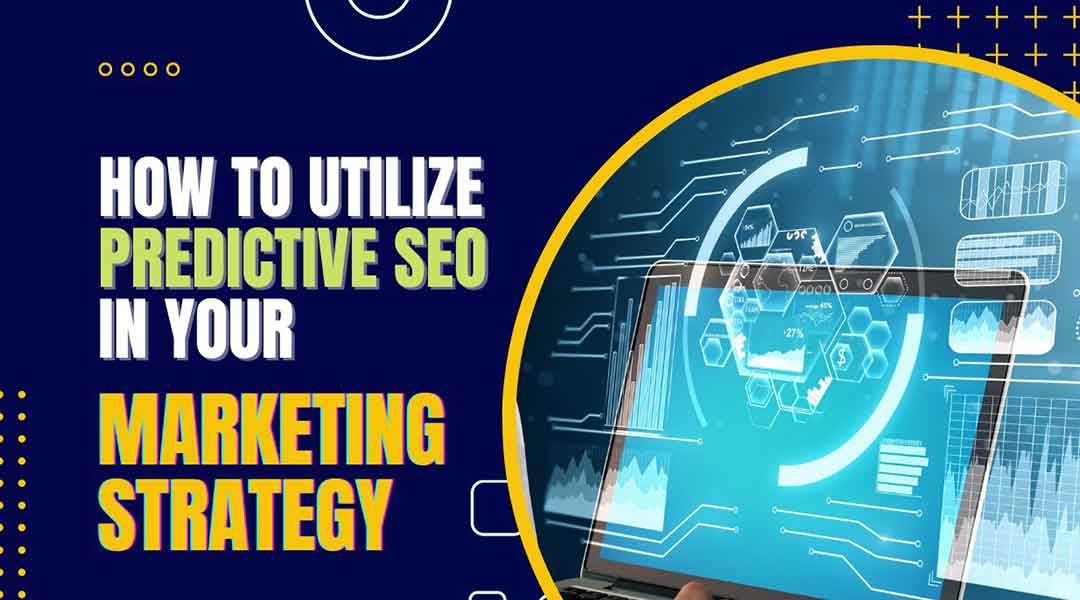With predictive SEO on the scene, businesses are suddenly equipped to make smarter, more informed decisions about their online presence. With advanced analytics and machine learning, predicting search trends becomes second nature, letting companies step ahead of the competition.
Don’t let your rivals get the best of you—harness the power of predictive SEO to supercharge your marketing strategy and leave them in the dust. Say goodbye to mediocrity—this approach supercharges your online presence and syncs your efforts with the people who matter most: your customers.
Let’s tune in to predictive SEO’s frequency. In this behind-the-scenes look, we’ll map out the perks of predictive SEO, identifying smart ways to sync it with your existing strategy. Bonus: We’ll also zero in on rookie errors to dodge and metrics to monitor for maximized results.
How Predictive SEO Works
Predictive SEO transforms how you approach your marketing strategy. This method’s fuel is information-rich, granular insights culled from the way people search and behave online, informing every move. Going through these datasets is like having a crystal ball—we can see what search queries are just around the corner.
AI and machine learning are vital components of predictive SEO. User search patterns and content effectiveness are their bread and butter—they pour over the data, spotting winning formulas and snagging trend shifts on the fly. Looking to up your online game? This tech zeroes in on the precise variables at play, arming you with sharp insight to fine-tune your strategy and climb the ranks.
Tools like Google Trends and SEMrush step in as trusted allies when it’s time to put our strategies into action. Armed with predictive analytics, you can turn your content from meh to mesmerizing. These applications diagnose where you’re falling short and offer a data-driven roadmap for ensuring your keywords hit the mark, both now and down the line.
Imagine crunching user stats alongside AI’s superpowered processing, and you get razor-sharp forecasting that sets us apart. This allows adjustments ahead of time, keeping websites one step ahead in relevance.
To dive deeper into harnessing predictive search marketing, understanding how software like MarketMuse operates is key. A global connection can be transformed by identifying the unspoken—the hidden opportunities hiding in plain sight within current content. That’s precisely what these high-tech platforms do, instantaneously.
Benefits of Predictive SEO for Your Marketing Strategy
Predictive SEO transforms how you approach your marketing strategy by enabling proactive adjustments for future trends. It leverages data analysis to predict shifts in user behavior and search patterns, offering a competitive edge.
- Anticipating Trends Before They Happen: This aspect of predictive SEO puts you ahead in identifying upcoming market changes. By recognizing these shifts early, you can adjust your content and keywords accordingly. This forward-thinking method ensures that when new searches begin trending, your company already ranks high for those terms. Not only does this improve visibility, but it also positions your brand as a niche authority.
- Improved Content Strategy: Forecasting the next big search trend allows for strategic content creation that meets anticipated needs or interests. By developing material in alignment with predicted search queries, engagement on your platform is likely to rise. This relevant content not only attracts more visitors but encourages longer stays on pages. Overall, it keeps your offerings fresh and closely aligned with what audiences will soon be actively searching for.
- Enhanced Keyword Targeting: Early identification of valuable keywords places you steps ahead of competitors who are using conventional methods. Focusing on these emerging terms means less competition and more chances to secure top rankings quickly. It enables an accumulation of authoritative weight under specific niches before they saturate, leading directly to increased site traffic from users looking precisely for what you’ve foreseen they’ll need.
Each point reinforces Predictive SEO’s role in shaping a deeply informed marketing strategy focused squarely on anticipating change rather than reacting—giving businesses critical leverage online amidst evolving user expectations and behaviors.
Steps to Integrate Predictive SEO into Your Marketing Strategy
To weave predictive SEO into your marketing blueprint effectively, start by gathering and dissecting historical data using platforms like Google Analytics and SEMrush. This step uncovers patterns in search trends, helping spot areas ripe for optimization. Next, pivot to leveraging AI-driven tools such as Clearscope or MarketMuse.
These resources excel at drilling down into forward-looking insights about content needs and keyword opportunities poised for growth. Then comes a critical move: perform comprehensive competitor analysis through Ahrefs or SpyFu. By understanding how rivals position their strategy, you can identify untapped niches or overlooked keywords that could benefit your plan.
Equipped with these insights, shift focus toward optimizing existing content and crafting new pieces that align with identified future trends.
Prioritize the incorporation of strategic keywords, engaging titles, and structured formats that both captivate readers’ attention and satisfy search algorithms’ preferences. Don’t overlook the power of long-tail keywords; they might be less sought-after now but have the potential for significant impact given their typically higher conversion rates. Vital for cornering niche segments ahead of the curve.
Develop a proactive link-building effort centered on upcoming trend predictions. Seek partnerships with authoritative domains relevant to your forecasted content paths to bolster credibility and visibility. Lastly, constant vigilance is critical.
Regularly monitor the performance against goals set out initially. And remain agile enough to adjust tactics as fresh data dictates adjustments are in order.
Best Practices for Predictive SEO
Predictive SEO allows you to anticipate changes and adapt your strategy for better search rankings. Here are a few best practices to follow:
- Stay Informed on Industry Trends: Staying current is key in the fast-paced world of SEO. Regularly read top SEO blogs, track Google’s algorithm updates, and review industry reports. This practice helps predict shifts in search behavior early on. Anticipating these changes lets you adjust your content strategy proactively rather than reactively.
- Focus on User Experience (UX): User satisfaction boosts rankings, plain and simple. Ensure your site loads quickly across all devices since speed is critical for online success. Make sure navigating it feels intuitive; this keeps users engaged longer—which search engines notice favorably—ranking such sites higher over time.
- AI Tools Utilization: AI tools streamline finding emerging trends before they become mainstream knowledge—a competitive edge worth having! Implementing AI into predictive analysis accelerates understanding of market direction with a precision never seen before. Remember, adapting fast pays off when keeping up with the ever-changing demands of both users and algorithms alike.
Common Pitfalls to Avoid in Predictive SEO
As you leverage predictive SEO in your marketing strategy, it’s crucial to avoid some common mistakes. First off, don’t depend too much on predictions alone. They’re helpful but should always be used along with real-time analytics.
Predictions might not always spot sudden market changes. Next is the quality of your content. It seems obvious, yet many overlook this aspect when chasing trends predicted by SEO tools.
Always ensure that whatever content you create adds value and is of high caliber because low-quality content can damage your brand’s image and rankings on search pages. Another pitfall is sticking rigidly to a plan without the readiness to change when necessary. The digital field moves quickly; if a trend doesn’t unfold as expected, being flexible enough to adjust strategies promptly will save wasted effort and resources.
Lastly, never forget about user intent. The goal behind every search query online. When crafting your content.
Forecasts from AI or other prediction methods don’t necessarily mean those pieces would resonate with actual human interests unless they align with what users genuinely seek online. By avoiding overconfidence in forecasts, delivering premium-grade material, and staying flexible in adapting strategies, your path to predicting future patterns for optimizing web presence becomes clearer. Aligning suggested topics through Artificial Intelligence insights with true consumer inquiries makes the process more productive.
Measuring the Impact of Predictive SEO
Predictive SEO helps to forecast trends and optimize content accordingly, offering a strategic edge. This segment explains how to measure the effectiveness of these efforts.
- Tracking Organic Traffic: Keep an eye on your website’s traffic for keywords you’ve predicted will gain popularity. If your predictions are accurate, you should see an uptick in visitors searching with those terms. Compare this data over time to identify patterns or shifts in audience behavior. Adjusting content based on these insights can enhance visibility and attract more targeted visitors.
- Monitoring Keyword Rankings: Watch closely how well your selected keywords rank in search results after implementing predictive SEO tactics. Improvements here signal that your strategy aligns well with what people are searching for online. Falling rankings indicate it might be time to reevaluate which phrases you’re targeting. Staying agile and adjusting keyword selection based on performance ensures sustained success.
- Assessing Conversion Rates: Determine if the traffic coming through predicted keywords actually leads to sales or other desired actions. A rise in conversions points towards not just higher relevance but also better alignment between user intent and offered solutions or information. Should conversions lag even as traffic grows, reassess whether site content meets visitor needs effectively. Fine-tuning landing pages according to conversion analytics paints clearer paths from discovery through users’ action steps.
Using predictive SEO in your marketing plan isn’t just smart; it’s essential. Start by analyzing data trends to forecast future searches. Adopt tools for better insight into user behavior and preferences.
Keep an eye on emerging topics within your niche, adapting content strategy accordingly. Remember, optimizing for tomorrow means understanding the shifts of today—from keyword evolution to changing algorithms. Integrating this forward-thinking approach ensures you stay ahead in the search game, keeping your content visible and relevant.










One comment
Judith Gilbert
October 27, 2022 at 12:33 pm
It’s definitely a must to optimize a website and be SEO-friendly. Amazing tips!
Comments are closed.